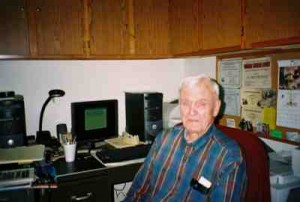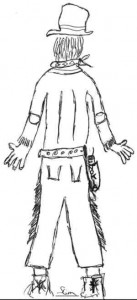Review by Martha Quillen
Science Fiction – September 2005 – Colorado Central Magazine
Gaudeamus
by John Barnes
Published by Tor in 2004
ISBN 0-765-30329-9
BACK WHEN I was an English major, science fiction was prodigiously popular, and I was actually introduced to Asimov, Clarke, Heinlein, and Herbert through assigned reading. But I turned into a sporadic sci fi fan at best, and gradually quit reading the genre altogether. Then, about two years ago, a friend recommended a book, and I started wondering what I was missing. So I decided to try reading more sci fi, and thus picked up Gaudeamus merely because it was on the new shelf at the library, and the first page seemed readable enough.
So imagine my surprise when it turned out that this book was set in Central Colorado. In Gaudeamus, John Barnes, the main character, is a sci fi author, WSC professor, and Gunnison resident (and yes, the main character and author have the same name and occupation, and the real names of many businesses in Central Colorado are also used — presumably to add to the fun and verisimilitude).
In the book, Barnes is visited by an old buddy who is a private investigator looking into the theft of a government-funded teleportation device, and that leads him to…. You guessed it: the San Luis Valley. And by the end of this book, the plot reveals just who and what are causing local UFO sightings and cattle mutilations.
Gaudeamus also revels in a debauched crew of comic characters, from Lena Logan, the grad school student/prostitute whose clientele includes government agents, nuclear physicists, and top secret security agents; to Skin2Skin, a really awful band that plays at a club called the Mutilated Cow in the Valley; and also Calvin Durango, Jenapha Lee, Brown Pierre, Melody, All Thumbs, and many more. (And in the acknowledgments section, the author thanks a number of real life locals for their help.)
As books go, Gaudeamus is neither terrific nor awful. It attempts to be very light and funny and to work on several levels: as comedy; as sci-fi; and as a witty, imaginative novel. But it reminded me of a so-so Saturday Night Live sketch. The talent and bright one-liners shine through, but the concept tends to get a mite convoluted and pretty flat in places.
Also, having almost all of the action told to the first person narrator (John Barnes) by a friend (Travis Bismarck) leads to some annoying confusion between just who “I” is in this book And I also found Travis’s stream-of-consciousness, good-old-boy style to be a bit too rambling and occasionally irritating.
BUT ON THE OTHER HAND, Barnes (the author) can be very funny, and the parts about Central Colorado are fascinating. Although Barnes is certainly not sci fi’s most polished writer, he is definitely irreverent, opinionated and jocular, and many of his descriptions of our region are amusing. But they’re seldom complimentary. For instance, he shows a healthy fondness for Gunnison, but writes:
“As we topped a rise, I was doing about eighty, taking a small risk of a ticket at that time of day – that area between Salida and Buena Vista is a notorious speed trap, because it’s so dull that people try to get through it as fast as they can….”
And here I always thought that same stretch was one of the most scenic in Colorado — what with it having so many fourteeners visible from the highway. But perhaps when you’re going eighty you don’t notice magnificent scenery.
And then there’s Barnes’s description of Crestone:
“It’s never going to have that kind of Christmas-card quaint that ski towns like Aspen or even Crested Butte do, which they get from their World War One railroad-and-mine-town architecture, because Crestone doesn’t have much that’s all that old left standing. It’s not going to look all Norman Rockwelly and small-town Christmas-card pretty like the older parts of Gunnison or Montrose or Salida…. Naw, the best thing that snow does for Crestone is hide most of it, because what it is, is a scattering of houses and buildings, most of them needing to hide.”
And further on:
“And yet if you just think of it [Crestone] as a collection of just-above-shacks among the pines and aspens, way high up, you’ll totally miss what the place is all about – the fact that Curt’s, besides being the gas station, is an art gallery and a bookstore, or that right out back of it there’s a New Age and Third World art store, or all the Buddhist flags and New Age symbols and the fact that that town has a couple liquor stores but probably twenty places you can buy crystals, more people who think they can levitate than people who think they can golf (and trust me, John, since you don’t golf, the percentage of people who are right about either, no matter where you are, is pretty much the same).”
Although Barnes is clearly mistaken about our beautiful valleys and towns, sometimes he’s right on. For example, here’s his take on interior decorating Rocky Mountain style: “Peering in the windows revealed the usual clunky fake-Southwest furniture that’s perfect if your friends routinely bring their plow horses on visits with them and insist on having them in their laps.”
So should you read it?
Well, ordinarily I’d only recommend this sort of book (one with flashes of excellence that tend to get lost in the excess) to true fans of its genre. But in this case the book is about Central Colorado, which is a very hard topic to resist.
So I leave it to you — because it all depends upon how you feel about conspicuously tangled plots, raunchy comedy, and a humorous but less-than-flattering view of home.


